Do you know that the average business person sends and receives over 100 emails daily? In such circumstances, it’s easy to see why most people hate getting promo messages.
But these people aren’t your new clients.
New business partners expect you to send a welcome email as soon as you seal the deal. That’s why your job is to design a good welcome message that sets the stage for a long-term relationship with a new client.
There are many ways to create and tailor welcome emails, so buckle up as we are about to show you some of the best tips and tricks on how to make it right.
Let’s take a look!
Got a new client? Onboard them with Content Snare
Chasing clients for information via email wastes time. Endless email threads are a sure-fire way to make your life miserable. Get the information you need from clients in record time with Content Snare
What is a welcome email?
A welcome email is a message you send to new clients upon establishing a partnership or completing the first purchase. It serves as an introduction to the firm or agency, creating preconditions for further engagement with the client.
Most companies use a welcome message as an easy way to build trust, especially if it offers immediate value like access to exclusive content. A warm welcome email generally contains information about:
- The way you’re going to cooperate
- Useful content like how-to-guides
- Social proof to show them they made the right choice hiring you
Of course, you may also include other relevant materials to engage new clients in their first direct interaction with the company. While you may automate the whole thing, most service-based companies opt for tailored messages because these sound better and more genuine.
| Welcome emails for clients vs customers Service businesses like accounting firms or web design agencies send a welcome email to new clients. These messages might include contact information, client expectations, and an outline of your process. On the other hand, product-focused businesses send welcome emails to customers. In this case, the goal of a welcome email is to inform users about new products, a special offer, or a discount code. |
Benefits of sending a welcome mail to a new client

Too many companies neglect welcome messages, often to their detriment. Here's what you get from sending a convenient welcome email to new clients.
Maximize engagement
A welcome email gives you the opportunity to engage quickly with clients. It's a great opportunity to introduce other services, your process, and to provide detailed instructions of what you expect from them.
It's an easy way to initiate a conversation with new clients and encourage them to stay in touch.
Boost loyalty
Sending a welcome email is also good for boosting loyalty. Well-crafted welcome emails don’t just introduce the company—they start meaningful conversations with clients, nurturing loyalty and trust. It’s a big deal if you know that a typical B2B firm generates nearly a third of its revenue from recurring customers.
Set expectations
When you establish a brand new business relationship, rest assured your clients expect to hear from you soon. Seize this chance to clarify further actions, communication frequency, and other relevant details. A welcome message is your channel to set expectations, providing a better experience and higher credibility.
Put their mind at ease
If clients sign a contract or make a payment and then don't hear anything from you for a while, they can start worrying. Sending an email right away can help alleviate that.
New client welcome letter: Key stats
How do we know that the power of welcome emails is so immense? We learned it from our own experience, of course! But why trust us when we can show you stats that prove our point. Here they are:
- Welcome emails have a standout 91% open rate
- Sending a client onboarding welcome email can see a 320% higher revenue than other marketing messages
- More than 70% of clients expect a welcome email as soon as they subscribe
- A welcome email generates four times more opens and five times more clicks than other types of emails
All things concerned, it’s clear that a client onboarding email can do wonders for your business in the long run. But how do you make a perfect welcome email template? We’ll check it out in the next section.
Onboarding welcome email to new client: Templates and best practices
Welcome emails come in all shapes and sizes, so feel free to test and experiment with different versions. But you don’t have to start from scratch. We picked the best welcome email examples that work well for all types of businesses, so let’s dive deep into the subject.
Template 1: Welcome message with product/service instructions
The idea of this new client onboarding email template is to provide instant help to first-time clients. Here’s how to do it:
| Subject line: Welcome to (company name)Thanks for joining us, (client name)! Our mission is to show you all you need to know in order to use our services successfully. Follow these steps for easy onboarding: Step 1Step 2…. If you have any questions, make sure to email us at (email address) or contact our customer support reps. Kindly,(your name) |
This client onboarding email template will kickstart the user journey, making your client feel comfortable from day one. Here’s an example of one such welcome email template:
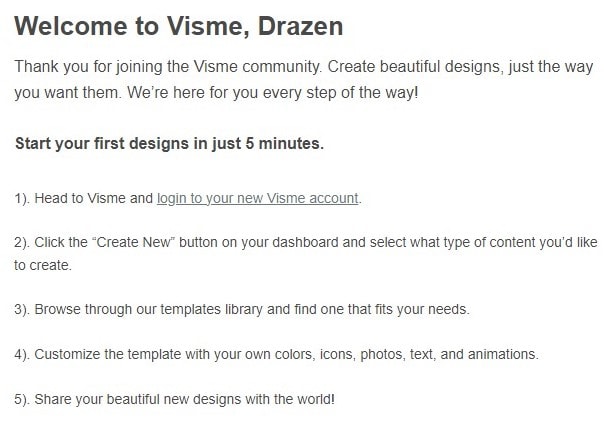
What makes this welcome email so good?
It instantly delivers instructions that new clients need in order to get used to the process. It’s a step-by-step guide, which is particularly useful for those who must familiarize themselves with the new tool or business procedures.
Template 2: Questionnaire or survey
You probably have many questions for the client, so it makes sense to begin with a practical questionnaire or survey. The advantage of this template is that you can point out two details:
- You care about your client’s opinion
- It doesn’t take too much time
Let’s see how that works in our template:
| Subject line: Let’s learn a bit more about you!Hey (client name), Glad to have you here! We are excited to show you what makes our company the industry leader. But before we blast off, you can help us out by answering some questions about your project. It helps us learn more about your needs, and it only takes a couple of minutes. Are you ready to help us out? Fill out the questionnaire |
As you can see, this welcome message is friendly and to the point. The questionnaire benefits both parties because you can tailor services and provide a better experience to your client. Business Class set a nice welcome email example:
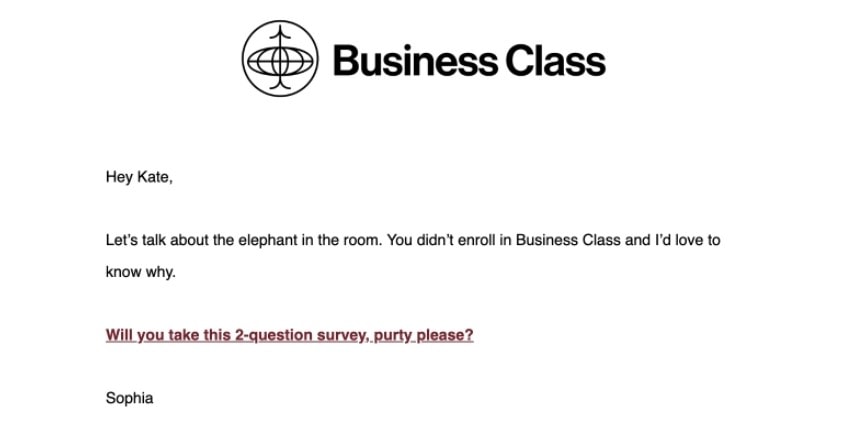
The thing we like about this example is the sheer simplicity mixed with a dose of humour. That way, the company establishes authority and asks for valuable feedback.
Related: Graphic design questionnaire: 30 questions to ask
Create questionnaires with Content Snare
Need a questionnaire? We’ve got you covered! Sign up to access our built-in questionnaire templates for graphic design, insurance, financial planning, and many more.
It’s ready when you are.
Start your trial
Template 3: KISS
KISS means: Keep it simple, stupid. The purpose of this welcome email template is to stick to the basics, reminding clients of the benefits of working with your company. Let’s take a look at the template:
| Subject line: Welcome aboard!Hi (client name) Thanks for working with us! With this guide, you can save up to ___ hours (doing what your guide suggests). The guide will help you: Explain benefit 1 Explain benefit 2… Take your ___ experience to a whole new level with this free resource! Cheers,(your name) |
This email is straightforward, which means it doesn’t suffocate readers with irrelevant information. We have a great welcome email example here, and it comes from none other than our company, Content Snare.
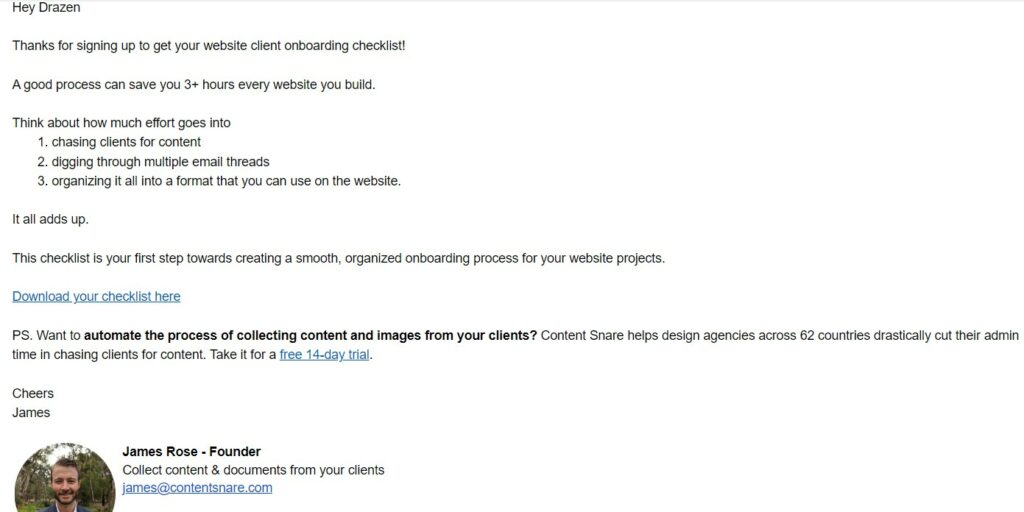
You can see that the message is clear and well-structured, helping email recipients focus on important details. Besides that, this welcome email template subtly leads clients to the next stage in the process—starting a free trial.
Template 4: Explainer video
Who says you can’t turn your welcome email into a video? All it takes is to add a brief introduction and let the video speak for itself. Of course, it requires some video production resources from your side, but it’s definitely worth the effort. Here’s how it looks:
| Subject line: Welcome, (client name)You’re all set up! Our agency will assist you with (mention a few popular features or services). You can use one of our standard services or place a totally unique order to kickstart your work. Check out this video to learn more: Embed video here |
Marketers often say to show and not tell. We think they have a point—and explainer videos quickly show how to get things done. A fine example comes from Notion:
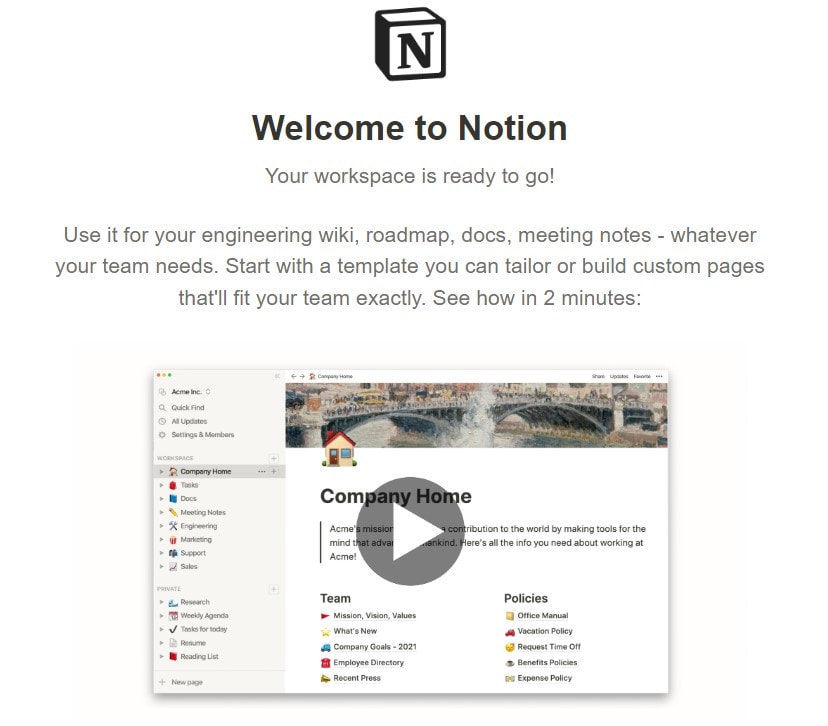
Videos make welcome email templates interactive, which means the recipient is more likely to engage. If you have the time and resources to produce high-quality video content, feel free to give it a try.
Template 5: Provide extra content
Most businesses design content at scale to increase visibility and keep the target audience engaged. In this case, you can offer marketing content as learning resources in welcome email templates. It can go like this:
| Subject line: Ready to start learning? Hey (client name) We prepared a bunch of inspirational learning resources for you. You have access to features like: How-to guidesFree eBooksInfographicsStats and reports Are you ready to give it a try?Cheers,(name from the company) |
Agencies with lots of quality content can use it to nurture relationships with new clients. It’s fairly easy to build this kind of welcome email template. Take a look at the example coming from HubSpot Academy:
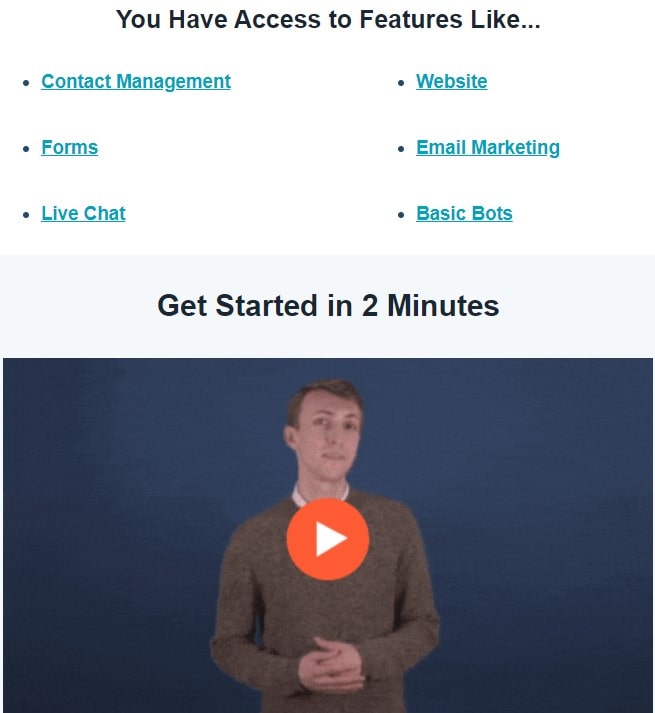
HubSpot earns a bonus point because it adds a short explainer video. But this template can work well without additional resources—it only takes a list of relevant learning resources to get the client engaging with your content.
How to craft a perfect welcome email: Key steps
You don’t have to use our welcome email templates—you are free to make one on your own. But if you want to do that, perhaps you can use a few tips to make your message well-crafted and effective.
Step 1: Start with a catchy email subject line
You get but one chance to make the first impression, so make it count with a catchy subject line. A welcome email subject line gives new clients a reason to open the message right away. The best solutions proved to be short and effective.
For instance, you can play with numbers because people love to quantify things. Another option is to personalize the subject line—refer to something you discussed with the client or heard from them. Such subject lines feel actionable and trustworthy, which is the best way to inspire recipients to keep reading.
Step 2: Introduce your company
It's critical to reassure new clients that they are talking to the right person. You should include the company name and logo in the first lines of the welcome message. That way, business partners will see who’s behind it right away.
You can also add a brief explanation of your company and its mission, emphasizing the values you stand for. If done right, this technique will help you build trust and make people feel like they are part of something special.
Step 3: Offer immediate value
Once you’ve introduced yourself, it's time to give something in return. Think about what would motivate a client to get in touch. We are talking about popular services that your clients are most likely to order.
For instance, this may be tax accounting or payroll processing for accounting clients. It all depends on what you have to offer and what will make the recipient get back to you. The bottom line is that you need to engage clients right away, making them feel appreciated and unique.
Step 4: Build anticipation
Another idea is to let them know what to expect from you in future emails. That way, clients won’t feel like they are getting yet another promo message every time they hear from you. Try to build anticipation by mentioning new services or industry events.
And if you're selling a complex product or service, perhaps it's time to announce extra help. You can promise to send tutorials and guides that will help clients onboard quickly. The only thing that matters is to ensure that recipients know what’s coming up, so they can look forward to it.
Step 5: Provide customer service details
Welcome emails must be brief and informative. Before you click the “Send” button, add customer support team contact details in case new clients have any questions or need extra help.
Include relevant contact points like customer service numbers, support emails, and social media accounts. Including these details at the end of the message encourages clients to reach out for help if they need it. This way, you show that your business is there for them right from the start.
Step 6: Invite clients to take further action
You never want to leave new clients without a clear next step. Make sure to add an invitation to take further action, like downloading a useful guide or signing up for a major event. It's also a channel to promote content such as free how-to guides, as well as the latest blog posts.
Step 7: Add social proof
Finally, don’t forget to add social proof elements that can add credibility to your company. User reviews, customer ratings, and case studies are just a few examples. Offering social proof in welcome emails helps clients build trust even before they get to know your business better.
You’ve sent a welcome email: What’s next?
So you’ve mastered the skill of building welcome email templates, but what is the next stage in the process? If you are like most businesses, you probably want to get as much information about your clients as possible.
But guess what—emails aren’t the way to do it.
It’s easy to get lost in the pile of mess as soon as you exchange more than a couple of messages and attachments, so you’ll need a special tool to obtain data with ease.
And that’s where Content Snare steps in to save your day.
Our platform makes it simple to request content, files, or data from new clients. Content Snare speeds up the process, helping companies improve efficiency, increase profitability, and minimize stress. Check out this video to see why our tool is so much better than email data gathering:
You can see that Content Snare streamlines data collection, so you and your team can become more productive. Forget about those endless email threads.
Organized data and file collection
Enough with the back and forth! Stop getting lost in emails and confusing shared docs.
Content Snare is like a checklist with automatic reminders for your clients.
Build client relationships with effective welcome emails
First impressions matter the most in every relationship. As a business, you should design welcome emails that set the stage for lasting relationships with new clients.
A personalized welcome email can do miracles for your marketing campaigns, so don’t be afraid of testing out different approaches. From informative emails to explainer videos, each tactic has its strengths and benefits.
Your job is to figure out what works with your prospective clients based on their interests and purchase histories. And don’t worry, you don’t have to be perfect—creating welcome emails gets easier with time.
Are you ready to give it a try?




